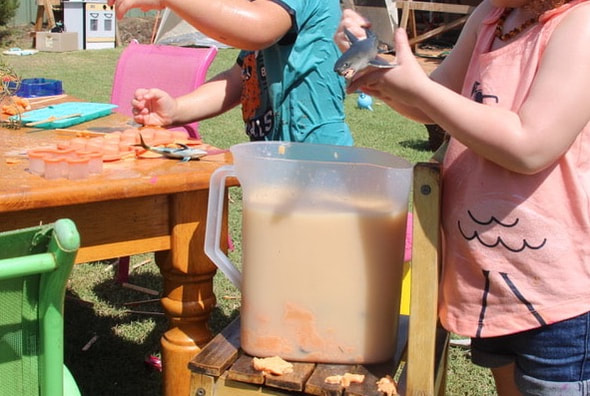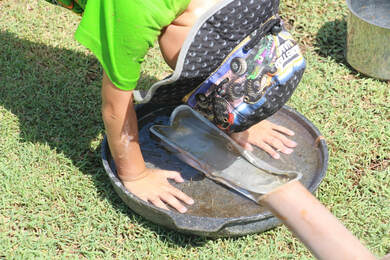Natural Learning
|
http://www.naturallearning.net.au
As educators we observe, plan carefully from the children's interest, reflect, identify the intentional teaching, we do necessary benefit risk assessments to ensure children are as safe as necessary, we source suitable materials and prepare thoroughly, we provide motivational resources to invite children into the play and then we hand the play over to the children - or do we? Jo had carefully planned a sensory experience with orange play dough, wooden sticks, a range of containers, utensils and herbs outside on a large wooden table. The children patted, moulded and poked the sticks into the dough, they tore off different size pieces and squeezed them into ice trays and other containers. They were fully engaged while Jo observed, critically reflected, provided, monitored, replaced hats, moved the shade umbrella without interfering in the play. SPLASH! A fishy blob moulded out of dough was dropped into the water jug with the other sea animals already in the jug, the dough settled at the bottom, more dough was added. "Look, we can see the whale and the fish in there," Lots of laughter and close observation as the children bent down to look from all angles. PLOP, an octopus joined the other creatures in the water, "oh, it broke, the legs fell off, don' worry, I got the head. It's wet, its slimy, ugh". He picked up a metal pot warmed by the sun placing the wet head/blob into it "to dry". The ice tray with dough was then submerged into the water and after a few minutes listen out. "Oh ugh, look, it's slimy, slimy, slimy, slimy" He squeezed and pressed down onto the tray, squeezed some more, laughing he commented "its making a noise, listen, it's a slimy noise" as he repeated the movements. "slimy, slime" as he stroked the wet dough on the table, back and forwards creating a milky film. "Look, look, I can't see in it" They looked from the top and from the side, the water had become milky and opaque, he dipped his hand in and 'found' hidden objects feeling around for different sea animals. The child initially reluctant to put her hand into the mixture became brave and joined in feeling, stirring, mixing and trying to see her hand through the side of the container. "I wonder why we can't see in the water anymore?" the educator asked, the children ignored the question, they were too busy investigating and experimenting to respond. One child made a small wet play dough ball and placed it into the funnel attached to a hose on the fence, he pushed it in and added water. It was a water wall after all. The water no longer flowed, the dough blocked it, he could see it in the pipe. A handfuls of wooden sticks from the table were used to try and push the dough further into the pipe. More water, one of the blobs moved with the water before getting stuck on the up slope. Looking, thinking and problem solving as he jiggled the pipe and pushed the sticks. Then he left to play and experiment something new, just like that! REFLECTION. An essential role of a professional. Jo had not planned for the newly made dough to be added to the water but quickly realised the benefits of allowing the children to continue their explorations and investigations as they were deeply and joyfully engaged in their own play. Their ideas were so much better than she could have anticipated or had planned for. Why did the child stop his investigation into the blocked pipe? Maybe he needed time to think and problem solve. Jo did not unblock the pipe or make any other changes leaving it to see if he would come back to it and he did! The next day he immediately ran to the funnel again attempted to try and unblock. the system. After numerous experiments he unblocked it with a hosepipe! What a lost opportunity it would have been if the educator had stopped the dough going into the water, had prevented the dough going into the funnel, had tidied up or unblocked the pipe overnight, Sometimes children too need to move away from the problem, reflect and come back again later. We as educators need to enable this. Assessment of Learning: science - sensory exploration, problem solving, experimenting, predicting, anticipating, property of materials, water force, scientific thinking, noticing, cause and effect, maths - size, volume, capacity, shapes, counting creativity - creative thinking, moulding objects, technology - using tools for a purpose such as funnel, pipe, sticks, pot, jug communication - verbal explanations, body language, vocabulary, expressive language connection - sharing experiences and thoughts with educator and peers. gross and fine motor development sense of agency ...................... just some of the learning observed. CHILDREN DEFINITELY HAVE THE BEST IDEAS! Thank you to Jo and the children in WA for letting me come and play too
0 Comments
Leave a Reply. |
AuthorNiki Buchan Archives
March 2022
Categories |














 RSS Feed
RSS Feed